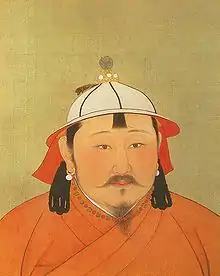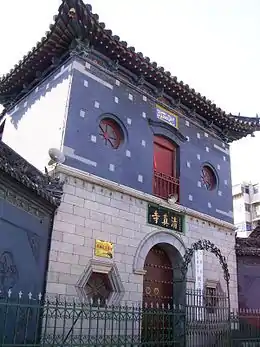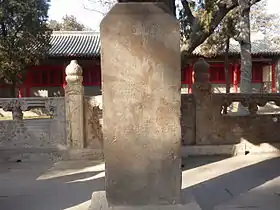Temür Khan
Temür Öljeytü Khan (Mongolian: Өлзийт Төмөр, romanized: Ölziit Tömör; Middle Mongolian: ᠥᠯᠵᠡᠶᠢᠲᠦ ᠲᠡᠮᠦᠷ, Öljeyitü Temür), born Temür (also spelled Timur, Mongolian: Төмөр, October 15, 1265 – February 10, 1307), also known by the temple name Chengzong (Emperor Chengzong of Yuan; Chinese: 元成宗; pinyin: Yuán Chéngzōng; Wade–Giles: Yüan2 Ch'eng2-tsung1) was the second emperor of the Yuan dynasty, ruling from May 10, 1294 to February 10, 1307. Apart from Emperor of China, he is considered as the sixth Great Khan of the Mongol Empire or Mongols, although it was only nominal due to the division of the empire. He was an able ruler of the Yuan, and his reign established the patterns of power for the next few decades.[1] His name means "blessed iron Khan" in the Mongolian language.
| Temür Öljeytü Khan Emperor Chengzong of Yuan 元成宗 | |||||||||||||||||
|---|---|---|---|---|---|---|---|---|---|---|---|---|---|---|---|---|---|
| 6th Khagan of the Mongol Empire (Nominal due to the empire's division) Emperor of China (2nd Emperor of the Yuan dynasty) | |||||||||||||||||
 Portrait of Temür Khan. Original size is 47 cm wide and 59.4 cm high. Paint and ink on silk. Now located in the National Palace Museum, Taipei, Taiwan. | |||||||||||||||||
| 2nd Emperor of the Yuan dynasty | |||||||||||||||||
| Reign | 10 May 1294 – 10 February 1307 | ||||||||||||||||
| Coronation | 10 May 1294 | ||||||||||||||||
| Predecessor | Kublai Khan | ||||||||||||||||
| Successor | Külüg Khan | ||||||||||||||||
| Born | 15 October 1265 | ||||||||||||||||
| Died | 10 February 1307 (aged 41) Khanbaliq, Yuan dynasty, Mongol Empire | ||||||||||||||||
| Consort | Bulugan | ||||||||||||||||
| |||||||||||||||||
| House | Borjigin | ||||||||||||||||
| Dynasty | Yuan dynasty | ||||||||||||||||
| Father | Zhenjin | ||||||||||||||||
| Mother | Kokejin (Bairam egchi) | ||||||||||||||||
Temür was a son of the Crown Prince Zhenjin (真金) and the grandson of Kublai Khan. During his rule, the western khanates of the Mongol Empire accepted his supremacy.
Early life
Temür was born the third son of Zhenjin of the Borjigin and Kökejin (Bairam-Egechi) of the Khunggirad on October 15, 1265. Because Kublai's first son Dorji died early, his second son and Temür's father, Zhenjin, became the crown prince. However, he died in 1286 when Temür was 21 years old. Kublai remained close to Zhenjin's widow Kökejin, who was high in his favor. Like his grandfather Kublai, Temür was a follower of Buddhism.
Temür followed his grandfather Kublai to suppress the rebellion of Nayan (Naiyan) and other rival relatives in 1287. Then he and Kublai's official, Oz-Temür, came to guard the Liao River area and Liaodong in the east from Nayan's ally, Qadaan, and defeated him. Kublai appointed Temür the princely overseer of Karakorum and surrounding areas in July 1293.[2] Three Chagatai princes submitted to him while he was defending Mongolia (they fled to Chagatai Khanate soon and returned to Yuan dynasty again during the reign of Temür).
After Kublai Khan died in 1294, Kublai's old officials urged the court to summon a kurultai in Shangdu. Because Zhenjin's second son Darmabala had already died in 1292, only his two sons, Gammala and Temür, were left to succeed. It was proposed that they hold a competition over who had better knowledge of Genghis Khan's sayings. Temür won and was declared the emperor.[3]
Reign
Temür Khan was a competent emperor of the Yuan dynasty. He kept the empire the way Kublai Khan left it though he did not make any great achievements. He continued many of Kublai Khan's economic reforms and tried to recover the economy from the expensive campaigns of Kublai Khan's reign. He allowed the empire to heal from the wounds of particularly the Vietnam Campaign. Many other high posts of his empire were filled with people of different origin, including Mongols, Han Chinese, Muslims and a few Christians.

Ideologically, Temür's administration showed respect for Confucianism and Confucian scholars. Shortly after his accession, Temür issued an edict to revere Confucius. Temür appointed Harghasun, who was particularly close to the Confucian scholars, right grand chancellor in the secretariat.[4] Nevertheless, the Mongol court did not accept every principle of Confucianism.[5] Temür bestowed new guards and assets on his mother and renamed her ordo (great palace-tent or camp) Longfugong palace, which became a center of Khunggirad power for the next few decades. Mongol and westerner statesmen were assisted by an array of Chinese administrators and Muslim financers. The most prominent Muslim statesman was Bayan (Баян), great-grandson of Saiyid Ajall Shams al-Din, who was in charge of the Ministry of Finance. Under Mongol administrators Oljei and Harghasun, the Yuan court adopted policies that were designed to ensure political and social stability. Orders were given that portraits be painted of the khagans and khatuns during the reign of Temür.[6]
The number of the Tibetans in the administration gradually increased. The Khon family of Tibet was honored, and one of them became an imperial son-in law in 1296. Temür reversed his grandfather's anti-Taoist policy and made Taoist Zhang Liusun co-chair of the Academy of Scholarly Worthies. In 1304, Temür appointed the Celestial master of Dragon and Tiger Mountain as head of the Orthodox Unity School. He banned sales and distillation of alcohol in Mongolia in 1297, and the French historian René Grousset applauded his activity in the book, The Empire of Steppes.
Temür was opposed to imposing any additional fiscal burden on the people. Exemptions from levies and taxes were granted several times for part or all of the Yuan. After his enthronement, Temür exempted Khanbaliq (Dadu, modern Beijing) and Shangdu from taxes for a year. He also exempted the Mongol commoners from taxation for two years. In 1302 he prohibited the collection of anything beyond the established tax quotas.[7] The financial state of the government deteriorated, however, and the draining of monetary reserves greatly weakened the credibility of the paper currency system. Corruption among officials of the Yuan became a problem.
During the last years of Temür, a peace among the Yuan dynasty and the western Mongol khanates (Golden Horde, Chagatai Khanate, Ilkhanate) was achieved around 1304 after the Kaidu–Kublai war that had lasted for more than 30 years and caused the permanent division of the Mongol Empire. Temür Khan was recognized as their nominal suzerain. While the peace itself was short-lived and the war soon resumed, this established the nominal supremacy of the Yuan dynasty over the western khanates that lasted for a few decades.
Because his only son Teshou died a year earlier (January 1306), Temür died without a male heir, in the capital Khanbaliq on February 10, 1307.[8]
Southeast Asia

Soon after his enthronement in 1294, Temür called off all preparations for further expansions to Japan and the Đại Việt, whose new ruler ignored his grandfather's envoy in 1291. Temür sent his messengers to Japan and Champa to demand submissions. Champa accepted the terms, but Kamakura shogunate declined, and the Japanese Wokou attacked Ningbo in Zheijiang province late in his reign.[9] The rulers of Đại Việt, Burma, and Sukhotai visited Khanbalik to greet him as their overlord in 1295, 1297, and 1300. In response to the visit from the prince of Burma, he aborted the Burmese campaign and said to all his ministers: "They are our friendly subjects. Do not attack their people". Temür also released envoys of Đại Việt to show his goodwill, and the Tran court began to send tributary missions. But Temür's government had to quell rebellions in the southwestern mountainous area, led by tribal chieftains like Song Longji and female leader Shejie in 1296. It took long months for the generals Liu Shen and Liu Guojie to suppress these rebellions.
By the request of the Burmese prince, Tribhuvanaditya, Temür dispatched a detachment of the Yuan army to Burma in 1297. They successfully repelled the Shans from Myanmar. Temür also received envoys from Siam and Cambodia. He dispatched Zhou Daguan to Khmer Cambodia in 1296, and Zhou wrote an account about his journey.[10] In 1299 Athinkaya murdered his brother Tribhuvanaditya, who submitted to Temür in 1297. In 1300, a punitive expedition was launched against Burma for dethroning Temür's protectorate, Tribhuvanaditya. The Shan warlords of Babai-Xifu, who were quarreling over the royal succession of Pagan, also raided the Yuan realms. Temür sent his Yunnan-based force in turn to halt the advance of Babaixifu (Lanna Kingdom of Chiangmai) in 1301–1303. Although those campaigns were fruitless, Athinkaya and the Shan lords offered their submission.[11] The costly expedition spurred rebellions of a Yunnan official, Song Longji, and the Gold-Tooths (ancestors of the Dai people) in 1301–03. The revolts were eventually suppressed. After Temür Khan ordered to withdraw his army from Burma, Central and southern Burma soon came under the Tai rulers who paid nominal tribute to the Yuan dynasty.
See also
- List of emperors of the Yuan dynasty
- List of Mongol rulers
- List of rulers of China
- Yuan dynasty in Inner Asia
References
Notes
- René Grousset The Empire of the Steppes, p. 320.
- Yuan shi, t8, p. 381.
- John Man, Kublai Khan p. 407.
- Twitchett, Dennis; Franke, Herbert, eds. (1994). The Cambridge History of China, Volume 6: Alien Regimes and Border States, 907–1368. Cambridge: Cambridge University Press. pp. 497–498. ISBN 978-0-521-24331-5.
- Jack Weatherford Genghis Khan and the making of the modern world
- Jan Stuart, Evelyn Sakakida Rawski, Freer Gallery of Art, Arthur M. Sackler Gallery Worshiping the ancestors, p. 41 ISBN 9780804742627
- Twitchett, Dennis; Franke, Herbert, eds. (1994). The Cambridge History of China, Volume 6: Alien Regimes and Border States, 907–1368. Cambridge: Cambridge University Press. p. 497. ISBN 978-0-521-24331-5.
- Twitchett, Dennis; Franke, Herbert, eds. (1994). The Cambridge History of China, Volume 6: Alien Regimes and Border States, 907–1368. Cambridge: Cambridge University Press. p. 505. ISBN 978-0-521-24331-5.
- Marvin C Whiting Imperial Chinese Military History, p. 408.
- René Grousset The Empire of the Steppes, p. 291.
- Praphatsō̜n Sēwikun, Sirindhorn, Thanākhān Kasikō̜n Thai From the Yellow River to the Chao Phraya River, p. 273.
Sources
- René Grousset The Empire of Steppes
- Цэен-ойдов Чингис Богдоос Лигдэн Хутаг хүртэл 36 хаад
- Man, John (2006). Kublai Khan: From Xanadu to Superpower. London: Bantam Books. ISBN 9780553817188.
Ancestors
| Ancestors of Temür Khan | |||||||||||||||||||||||||||||||||||||||||||||||||||||||||||||||||||||||||||||||||||||||||||||||||||||||||||||||||||||||||||||||||||||||||||||||||||||||||||||||||||||||||||||||||||||||||||||||||||||||||||||||||||||||||||||||||||||||||||||||||||||||||||||||||||||||||||||||||||||||||||||||||||||||||||||||||||||||||||||||||||||||||||||||||||||||||||||||||||||||||||||||||||||||||||||||||||||||||||||||||||||||||||||||||||||||||||||||||||||||||||||||||||||||||||||||||||
|---|---|---|---|---|---|---|---|---|---|---|---|---|---|---|---|---|---|---|---|---|---|---|---|---|---|---|---|---|---|---|---|---|---|---|---|---|---|---|---|---|---|---|---|---|---|---|---|---|---|---|---|---|---|---|---|---|---|---|---|---|---|---|---|---|---|---|---|---|---|---|---|---|---|---|---|---|---|---|---|---|---|---|---|---|---|---|---|---|---|---|---|---|---|---|---|---|---|---|---|---|---|---|---|---|---|---|---|---|---|---|---|---|---|---|---|---|---|---|---|---|---|---|---|---|---|---|---|---|---|---|---|---|---|---|---|---|---|---|---|---|---|---|---|---|---|---|---|---|---|---|---|---|---|---|---|---|---|---|---|---|---|---|---|---|---|---|---|---|---|---|---|---|---|---|---|---|---|---|---|---|---|---|---|---|---|---|---|---|---|---|---|---|---|---|---|---|---|---|---|---|---|---|---|---|---|---|---|---|---|---|---|---|---|---|---|---|---|---|---|---|---|---|---|---|---|---|---|---|---|---|---|---|---|---|---|---|---|---|---|---|---|---|---|---|---|---|---|---|---|---|---|---|---|---|---|---|---|---|---|---|---|---|---|---|---|---|---|---|---|---|---|---|---|---|---|---|---|---|---|---|---|---|---|---|---|---|---|---|---|---|---|---|---|---|---|---|---|---|---|---|---|---|---|---|---|---|---|---|---|---|---|---|---|---|---|---|---|---|---|---|---|---|---|---|---|---|---|---|---|---|---|---|---|---|---|---|---|---|---|---|---|---|---|---|---|---|---|---|---|---|---|---|---|---|---|---|---|---|---|---|---|---|---|---|---|---|---|---|---|---|---|---|---|---|---|---|---|---|---|---|---|---|---|---|---|---|---|---|---|---|---|---|---|---|---|---|---|---|---|---|---|---|---|---|---|---|---|---|---|---|---|---|---|---|---|---|---|---|---|---|---|---|---|---|---|---|---|---|---|---|---|---|---|---|---|---|---|---|---|---|---|---|---|---|---|---|---|---|---|---|---|---|---|---|---|---|---|---|---|---|---|---|---|---|---|---|---|
| |||||||||||||||||||||||||||||||||||||||||||||||||||||||||||||||||||||||||||||||||||||||||||||||||||||||||||||||||||||||||||||||||||||||||||||||||||||||||||||||||||||||||||||||||||||||||||||||||||||||||||||||||||||||||||||||||||||||||||||||||||||||||||||||||||||||||||||||||||||||||||||||||||||||||||||||||||||||||||||||||||||||||||||||||||||||||||||||||||||||||||||||||||||||||||||||||||||||||||||||||||||||||||||||||||||||||||||||||||||||||||||||||||||||||||||||||||
Temür Khan Born: 1265 Died: 1307 | ||
| Regnal titles | ||
|---|---|---|
| Preceded by Kublai Khan |
Great Khan of the Mongol Empire (Nominal due to the empire's division) 1294–1307 |
Succeeded by Külüg Khan, Emperor Wuzong |
| Emperor of the Yuan dynasty 1294–1307 | ||
| Emperor of China 1294–1307 | ||